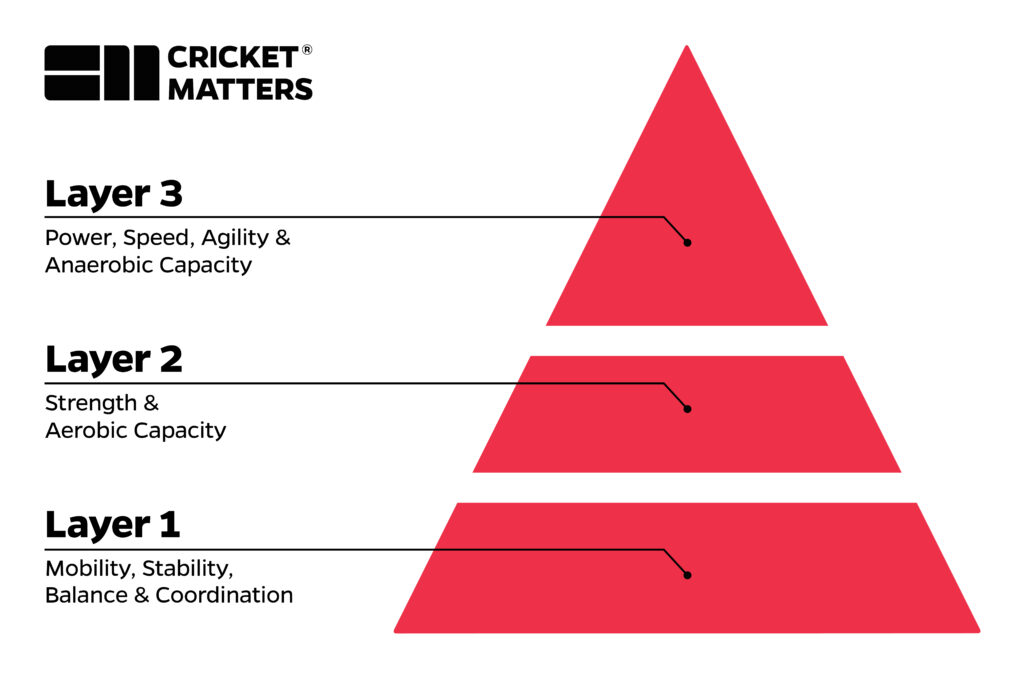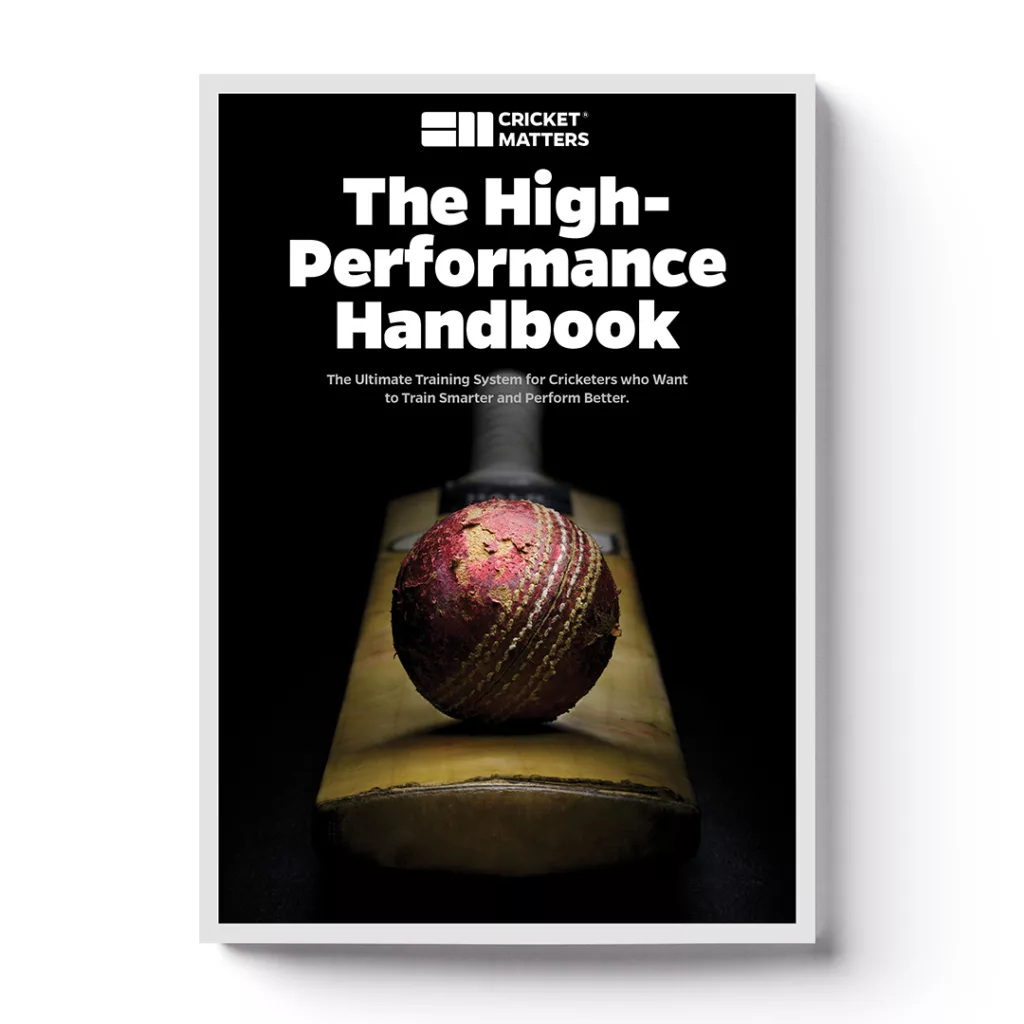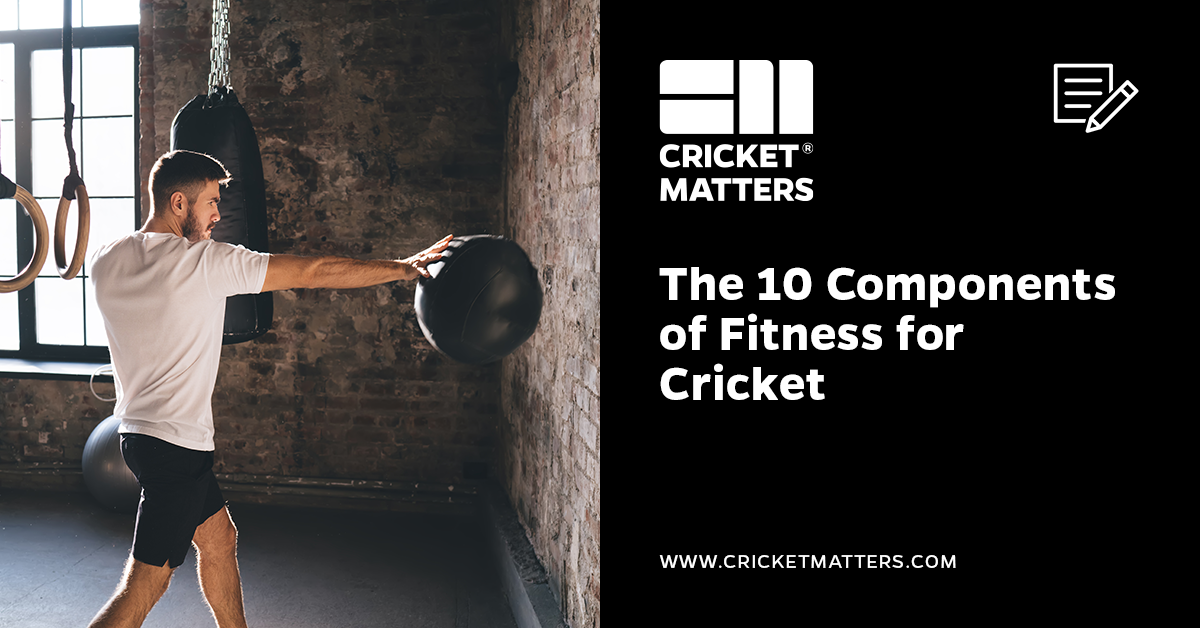
I hope you enjoy reading this blog post.
James Breese, Cricket Matters FounderIf you need my help with cricket coaching, strength and conditioning, injury rehab, or nutrition, click here.
I believe the ten critical components of fitness for cricket make up balanced physical fitness, or what we prefer to call the ultimate athletic cricketer.
They are strength, speed, power, agility, anaerobic capacity, aerobic capacity, mobility, balance and coordination, mental resilience, and stability.
This article is based on the original I wrote for Strength Matters: What is Athleticism: The 10 Components You Must Know.
The best part is that I discovered these components of fitness for cricket and athleticism after returning to play cricket after a long break from the game.
So, let’s dive in to help you become the ultimate athletic cricketer.
Table of Contents
How I Discovered the 10 Components of Fitness for Cricket
In late September 2016, the beginning of spring in Melbourne, Australia, marked a pivotal time for me.
One sunny Sunday morning, my girlfriend and her sister invited me for a run followed by coffee.
Having not run for six years due to a focus on strength training, I struggled immensely during the run, unable to keep pace and forced to walk after just a few minutes.
As a fitness professional, this was embarrassing and a wake-up call.
It changed my view on training, leading me to incorporate a walk/run protocol into my routine to ensure I never felt unprepared to run again.

A few weeks later, in mid-October, a casual chat inspired me to revisit my long-lost dream of playing cricket in Australia, which I had halted years ago due to a shoulder injury.
After several weeks of running and feeling revitalised, I attended a Tuesday night cricket practice, my first in six years—the same period I had shifted focus to weight training and ceased running.
Reflecting on it, I regretted quitting cricket, which was a significant part of my childhood.
It was daunting to return to play cricket as a Brit in Australia, where there’s a notable cricket rivalry. My performance was embarrassingly poor; I struggled with batting, catching, and bowling.
The Australian fast bowlers didn’t go easy on me, leaving me bruised and battered, feeling like I’d been run over by a bus.
Despite the blow to my ego, this experience catalysed change.
It reminded me that, although strong, I lacked cardiovascular health, flexibility, agility, and coordination—I was fundamentally unathletic.
This realisation spurred me to research and transform into a capable, athletic cricketer, aiming to reclaim my former prowess.
What is Athleticism?

Approaching the issue with professional detachment, I sought to objectively define athleticism and its essential components, aware that ‘athleticism’ can mean different things to different people.
My initial search through Google and Merriam-Webster offered definitions emphasizing strength, fitness, and agility, but these were too vague to be practically helpful.
Frustrated by the lack of concrete guidance, I decided to take the initiative.
Drawing on the pioneering work of Tudor Bompa, a renowned strength and conditioning expert, I proposed a model outlining seven key components of fitness for cricket and complete athleticism to the Strength Matters team.
This sparked extensive debates and discussions, culminating in a consensus on ten critical components of fitness for cricket and athleticism.

Have You Downloaded Our FREE 7-Day Gym Workout Plan?
Grab your complete step-by-step 7-day gym workout plan for cricketers today. There will be no more Guesswork. Just follow the plan and get results.
The 10 Components of Fitness for Cricket
We defined the ten components of fitness for cricket as:
- Strength – the ability to generate force.
- Speed – the ability to reduce the duration of a movement cycle.
- Power – the ability to generate maximum force in the shortest time.
- Mental Resilience – the capacity to challenge and expand your comfort zone.
- Aerobic Capacity – the maximum physical work an individual can perform, measured by oxygen consumption.
- Anaerobic Capacity – the maximum effort exerted in short, intense bursts of physical activity.
- Balance & Coordination – the ability to execute movements with precision and elegance.
- Agility – the capability to move swiftly and seamlessly between different movement patterns.
- Stability – the skill to maintain control of one part of the body while moving another, safeguarding vulnerable areas.
- Mobility – the ability to move joints and muscles through their full range of motion.
After defining these ten components of athleticism, I assumed the debate was settled. However, the discussion was far from over.
For an additional six months, we engaged in intense debates and analyses driven by numerous critical questions:
- Which component is the most crucial?
- How should we evaluate each component?
- What standards should be set for each?
- How can we integrate these components into training regimens?
These questions led to the development of the Cricket Matters Athletic Performance Pyramid, designed to bring structure, logic, and clarity to the comprehensive components of athleticism.
The Cricket Matters Performance Pyramid
After identifying the ten essential components of fitness for cricket and athleticism, we faced the challenge of prioritizing them.
Rather than ranking them sequentially from one to ten—a method that proved unfeasible due to their equal importance—we opted for a more holistic approach.
We likened the process to constructing a house, which requires a solid foundation before the structure can be built and the final touches applied.
Consequently, we organized the components into three tiers of fitness: Layer 1, Layer 2, and Layer 3, grouping them based on the foundational skills needed before advancing to the next level.
This structure ensured a balanced development in key areas, recognizing that competence in certain aspects is necessary before others.

Balanced Fitness and the Athletic Cricketer
Our concept of balanced fitness and athleticism for cricket crystallized with the creation of the Performance Pyramid.
Layer 1 forms the fundamental base of our system.
It focuses on essential mobility, stability, balance, and coordination—the foundation of our “house.”
Deficiencies in these areas can slow progress and increase the risk of injuries.
Layer 2 builds on this foundation with strength and aerobic capacity.
With a solid Layer 1 base, we add basic strength training and aerobic exercises, setting the stage for more advanced athletic development.
Layer 3, often seen as the most desirable, is where advanced athletic skills are honed.
This layer includes power, speed, agility, and high-intensity interval training (HIIT).
It’s attractive but comes with the highest risk of injury, particularly if lingering deficiencies from the previous layers remain.
We recognised the critical role of mental resilience across all layers.
Given its significance in all aspects of life and sports, particularly cricket, we integrated mental resilience as a core theme throughout the pyramid.
The Cricket Matters Performance Pyramid serves as a diagnostic tool to pinpoint weaknesses that need attention.
It has evolved into a comprehensive system that helps professional cricketers achieve their peak physical potential and aids club and grade cricketers in reducing injury risks.
This system ensures a targeted approach to training weaknesses, offering a clear pathway for pro and club cricketers to understand and improve their athletic capabilities.
Additionally, it serves a personal purpose: it’s a system that helps me, an ageing cricketer, to keep playing to the highest levels as long as possible.
The Benefits of Hindsight

I’m profoundly grateful for those challenging days in Melbourne—running and being outplayed by the Aussies.
These experiences were crucial turning points in my journey as an ageing cricketer.
Today, I’m fitter, stronger, and more agile than ever, having reclaimed my athletic identity through hard work and perseverance.
Before these wake-up calls, I mistakenly believed that strength training was the sole component of fitness.
I overlooked my weaknesses and the broader aspects of balanced athleticism for cricket.
I ignored signs of declining health, such as breathlessness on stairs, increasing body fat, morning stiffness, and frequent pain that necessitated visits to a chiropractor.
Reflecting on this period, I realize I was overly focused on Layer 3 activities like power training, neglecting speed, agility, aerobic conditioning, and mobility.
My training lacked variety, focusing only on intense, short-duration exercises and missing out on endurance work.
This reality check was necessary. Without it, my later years could have been marred by physical limitations.
Now, I’m equipped not only to enjoy playing club cricket but also to play cricket at the highest levels again, and for me, that was at the recent Over 40s Cricket World Cup in Cape Town.
This journey has taught me the true essence of athleticism and the importance of a well-rounded training plan that includes the ten components of fitness for cricket.
Final Thoughts: The 10 Components of Fitness for Cricket
I’ve outlined ten essential components of fitness for cricket and introduced the Cricket Matters Performance Pyramid for holistic athlete development.
This system encourages us to objectively view our athletic progress as a cricketer, providing a clear framework for identifying and addressing areas needing improvement.
Using this pyramid daily in our coaching, we help cricketers focus on their athletic weaknesses by treating the body as a holistic system. This demonstrates that your overall athletic ability is limited by your weakest component.
Adhering to this structured approach can significantly enhance your performance on the cricket field and in all your other favourite sporting activities.
Ignoring your weaknesses, however, may result in serious injuries and chronic deficiencies.
Something I see time after time with cricketers who are constantly injured.
Learn from my experiences: achieving balanced athleticism makes being a cricketer a more enjoyable and rewarding experience.
- You’ll have the energy to convert those 30s and 40s into 100s.
- You’ll have the stamina to bowl more than three to four overs in a row.
- You’ll get injured less often. Period.
To avoid the pitfalls I encountered and to deepen your understanding of our system, I recommend downloading our free e-book – The High Performance Handbook for Cricketers.
It’s a valuable resource for mastering our comprehensive approach to the athletic development of cricketers.

Further Reading
FAQs
What Are the Key 10 Components of Fitness Required for Cricket?
The 10 key components of fitness required for cricket include strength for generating force, speed to reduce movement time, power for quick, forceful actions, and mental resilience for enduring game pressures. Aerobic capacity maximizes sustained activity, while anaerobic capacity supports short, intense efforts. Balance and coordination enhance movement precision, agility for quick transitions, stability for controlling body movements, and mobility for full range of motion are also essential. Each component uniquely contributes to the multifaceted demands of cricket.
How Can I Improve My Cricket Fitness?
To improve your cricket fitness, focus on enhancing the key fitness components like strength, speed, and aerobic capacity through targeted training. Incorporate resistance training for strength, sprint drills for speed, and interval training for aerobic and anaerobic fitness. Work on agility and balance through specific drills, and improve mobility and stability with exercises like yoga or Pilates. Mental resilience can be developed through mental conditioning and stress management techniques. Consistency and a well-rounded approach are crucial.
What Role Does Agility Play in Improving Cricket Skills?
Agility enhances a cricketer’s ability to make quick movements and changes of direction, which are key during fielding to catch the ball and while batting to adjust to different types of deliveries. This quickness can be the difference between making a successful play and missing an opportunity.
Why Is Aerobic Capacity Important for Cricket Players?
Aerobic capacity is vital for cricketers as it allows sustained physical activity, essential during long spells of bowling or batting and fielding throughout a day. Good aerobic fitness helps players maintain their performance level without fatigue, contributing to better concentration and skill execution.
How Does Mental Resilience Impact a Cricketer’s Performance?
Mental resilience is crucial in cricket, helping players handle pressure situations, stay focused during long games, and recover from setbacks. This mental toughness supports decision-making under stress and can significantly influence the outcome of matches.
Which Components of Fitness are Important in Cricket
All ten components of fitness are important for cricket, including strength, speed, power, mental resilience, aerobic and anaerobic capacities, balance, coordination, agility, stability, and mobility. Each player should assess their own performance to identify areas of weakness that need improvement, as focusing on these areas can greatly enhance overall cricket fitness and performance. Balancing all components effectively contributes to a comprehensive fitness regime tailored to cricket.



